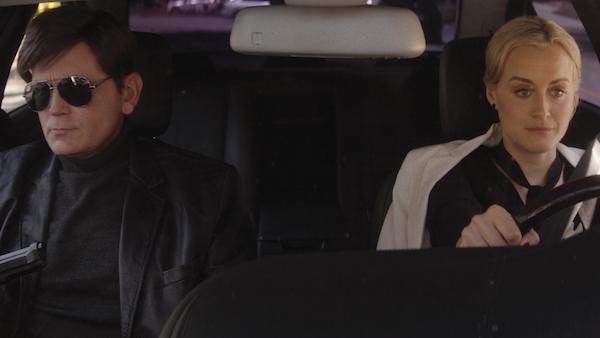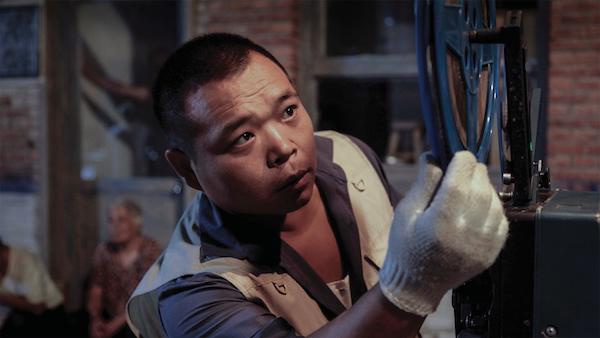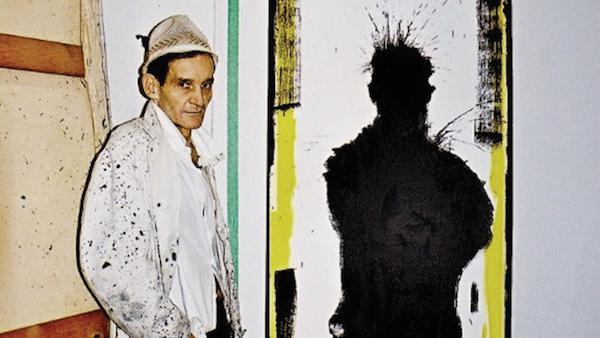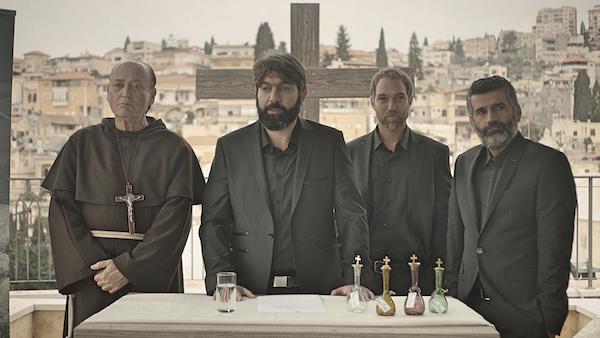THE TRIBECA FILM FESTVAL presents screenings and events through April 30. More reviews will be added to this roundup, once the film’s first festival screening has taken place. If you’re reading this after a particular film’s last festival screening, take heart — many of the fest’s flicks are picked up for theatrical distribution later in the year, become available On Demand via your local cable provider, or appear on various streaming services.

TAKE ME
Narrative
Directed by Pat Healy
Screenplay by Mike Makowsky
Runtime: 84 minutes
—Thurs., 4/27, 5pm & Fri., 4/28, 8:45pm at Cinépolis Chelsea (260 W. 23rd St., btw. 7th & 8th Aves.).
—Sat., 4/29, 3:30pm at Regal Cinemas Battery Park (102 North End Ave., at Vesey St.).
REVIEW BY CHARLES BATTERSBY | The core of any good story is characters who undergo a change of status. The mighty are brought low, the underdog rises to the challenge, or the oppressed cast off their chains. Nothing captures this dynamic quite as well as sadomasochism, where the submissive demands to be punished while the dominant complies. The film “Take Me” isn’t really about S&M, but it does involve a professional kidnapper, his consenting victim, and great deal of humorous confusion about which of the two in really in charge.
Surviving a traumatic event can also be a life-changing moment. Ray (played by director Pat Healy) tries to help people get in touch with their most primal selves, by kidnapping them — consensually, and for a modest fee. Early on in “Take Me,” Ray demonstrates these therapeutic results by kidnapping a portly fellow to help cure his overeating. Later on, he shows off a wall full of pictures of other satisfied customers.
Despite Ray’s extreme enthusiasm, his unconventional business isn’t going well. His financial problems seem to be solved when a mysterious woman named Anna (played by Taylor Schilling from “Orange Is the New Black”) wants to book a lengthy kidnapping session, at a high price.
Ray, and the audience, have reason to be suspicious right from the start. Ray likes to think that he runs a legitimate business, providing an alternative form of therapy, rather than an erotic fantasy. Anna, on the other hand, seems more interested in pushing Ray’s boundaries regarding how sternly he punishes his clients. Much like a cash-strapped dominatrix, Ray takes the job.
Anna’s “kidnapping” quickly turns into a series of zany misunderstandings. However, there are several possible explanations. Was Ray set up? Anna? Are both of them being manipulated by some malevolent third party? Most of the movie is spent watching the two try to figure out what’s happening. The two characters are experiencing the same events, but from wildly different perspectives, and only one of them is fully aware of what’s going on at any moment. The audience is then left to puzzle out which of many possible twists will turn out to be true.
Most of the film features these two characters alone in a room or car. It’s almost a theater piece as opposed to a film, and Ray’s work actually is a form of bad theater. Pat Healy plays the role as though Ray is ineptly trying to replicate “tough guy” characters from movies about hard-boiled kidnappers. His obvious toupee, and inconsistent grit make him seem like the long shot in a battle of wills against Anna. Meanwhile, Schilling plays Anna as a femme fatale half the time, but she’s also a damsel when convenient. The audience is less certain of her motivations, while Ray is wearing a paper thin persona.
Some audience members will see that final plot twist coming right from the start, but “Take Me” is still a fun ride, watching the earnest efforts of a lovable loser who tries to do good in the world, one kidnapping at a time.

KING OF PEKING
Narrative
Written & Directed by Sam Voutas
Runtime: 88 minutes
—Fri., 4/21, 5pm & Sun., 4/30, 6:15pm at Regal Cinemas Battery Park (102 North End Ave., at Vesey St.).
—Sat., 4/22, 7:45pm & Sat., 4/29, 7pm at Cinépolis Chelsea (260 W. 23rd St., btw. 7th & 8th Aves.).
REVIEW BY RANIA RICHARDSON | One of the joys of watching foreign films is being immersed in another culture. The sights, sounds, people and places can shrink our world and create compassion for those from around the globe. We can also discover commonalities and mutual concerns.
In the “King of Peking” we travel back to China for one summer in the 1990s and meet a father (Big Wong) and young son (Little Wong) who drive a mobile cinema from village to village, screening Hollywood blockbusters for the locals. When their projector fails, the ingenious father comes up with a plan to secretly copy films and sell them as home video discs by using the resources of his janitorial job in an old Beijing movie theater (video discs were very popular at the time, and an entire subculture of bootlegging took hold internationally). Hilariously, the father-son pair do their own dubbing for the new underground business, and even recreate classics in the DIY-style seen in films like “Be Kind Rewind” and “The Wolfpack.”
Big Wong is at odds with his ex-wife for custody of their son, and he thinks that the illegal scheme will give him the money he needs for leverage. In the ruthless environment he lives in, though, his plan for easy money is too good to last. His ex-wife doesn’t present the best lifestyle for parenting, either. She works in transit all day as a low-level railway snack vendor, calling out, “Instant noodles, Spam, beef jerky” on train cars. She is suspicious of her ex and accuses him of exploiting Little Wong by forcing him into child labor.
Writer/director Sam Voutas, an Australian living in China, was inspired to write the story after his film “Red Light Revolution” was pirated. While “King of Peking” does present piracy in a negative light, its larger theme is the effect of cheating the system in general, and the unintended consequences of a father’s questionable activities on his son, albiet with a lighthearted spin.
Wong wants respect and admiration, but doesn’t see the larger picture. He is doing the best he can in a difficult environment where jobs are hard to get — and to keep — especially for one with more pluck than skill. Nevertheless, without maintaining his ethics, he loses the trust of Little Wong, with whom he once shared a close-knit bond.
The endearing Mandarin-language tale depicts the meaning of parenthood and the transformation of a family through forgiveness and patience. Atmospheric and endlessly amusing, the film is also a tribute to the film industry.
With Chinese (including Cantonese and Mandarin) being the second largest foreign language spoken in New York City (after Spanish), “King of Peking” is right at home in the Tribeca Film Festival. A general audience crowd-pleaser, it would be a great pick for Chinese speaking families and for New Yorkers of all stripes who would like a glimpse of China in the not-so-distant past.
For info on screenings and events, visit tribecafilm.com/festival — where you can also purchase tickets and get info on the RUSH standby seating policy. To order by phone, call 646-502-5296 ($21, evening/weekend; $12, matinee; $3.50 service fee, per ticket, applies for web and phone orders).

SHADOWMAN
At The Tribeca Film Festival
Documentary
Directed by Oren Jacoby
Runtime: 83 minutes
—Mon., 4/24, 10:15pm & Fri., 4/28, 5:45pm at Cinépolis Chelsea (260 W. 23rd St., btw. 7th & 8th Aves.).
—Sat., 4/22, 8:30pm at Regal Cinemas Battery Park (102 North End Ave., at Vesey St.).
REVIEW BY PUMA PERL | If you were Downtown in the ’80s, you probably ran into the startling work of Richard Hambleton. His life-size shadow silhouettes and the crime scenes of the “Image Mass Murder” series were around every corner. Penny Arcade, one of many participants in the film, recalls being terrified of them, feeling like they might jump down on her. A brilliant painter and art school graduate, Hambleton brought his talents to the street in ways nobody had before.
The opening scene is 1981 footage of Hambleton painting a Shadow Man on a tenement building. We notice several cars on the deserted street, “Ghost Rider,” by Suicide, and disembodied voices begin to describe Hambleton. Two themes run throughout: brilliance and self-destruction. The camera follows Hambleton as he finishes his work and hurries off in the darkness.
Hambleton’s work was acclaimed critically and commercially in the early ’80s. He travelled extensively and was widely shown. While associated by the public with Keith Haring and Jean-Michel Basquiat, his skills were much more painterly and he considered his work an experience, rather than an exposure. He’s described in the film as “more visiting royalty than graffiti artist.” Footage shows him entering parties, always with a gorgeous woman on his arm. “Girls loved Richard,” said his longtime friend Anne Hanavan, with a laugh. Richard Hell also remarks on his GQ style and looks.
Despite, or because of the success and admiration he received, he never embraced the art world. As the East Village gallery scene exploded, he veered off into what is known as the “Beautiful Painting” series, which were, indeed, beautiful, but not what people wanted. As poet Michael Carter put it, “He was always on his own wavelength.” Then came the free fall. While the drug and art scene were intertwined, Hambleton hit a bottom few survive. One gallery owner recalls running into a disheveled man on the street that was trying to sell a painting for $100 — it turned out to be Hambleton. He sometimes traded his artwork for food in nearby restaurants. He lost his loft, lived in a hovel with other addicts, was evicted, and moved into a metal shed at Gas, an art space on East Second and Avenue B, former site of a Mobil Station.
No matter the circumstances, he never stopped working. “He would paint in blood if he had to,” said Hanavan, who lived and used drugs with him in the early ’80s, and appears as strung-out as Hambleton in footage shot by Clayton Patterson during that period. Hanavan, sober for years, is now an artist and businesswoman, and is luminous onscreen. Hambleton has disappeared and reappeared on the scene several times and has been exploited as many times as he has been rescued. He’s notoriously difficult to work with, is crippled with scoliosis, and has lost part of his face to skin cancer, which he’s refused to treat. Despite illness, repetitive homelessness, and addiction, he has still never stopped working. The film ends, fittingly, with the Ramones song “Outsider” rolling over the credits.
As Hanavan told me, “Life is a gift of experiences. Some wonderful, some dark and dangerous. Sometimes it’s all those things happening at once.”
For info on screenings and events, visit tribecafilm.com/festival — where you can also purchase tickets and get info on the RUSH standby seating policy. To order by phone, call 646-502-5296 ($21, evening/weekend; $12, matinee; $3.50 service fee, per ticket, applies for web and phone orders).

HOLY AIR
Narrative
Written & Directed by Shady Srour
Runtime: 81 minutes
—Fri., 4/21, 8:45pm, Sat., 4/22, 3:30pm & Fri., 4/28, 6:15pm at Regal Cinemas Battery Park (102 North End Ave., at Vesey St.).
REVIEW BY CHARLES BATTERSBY | What makes people in the Middle East laugh? Pitch black humor, if the movie “Holy Air” is any indication. It is an Israeli film shot on location in Nazareth, a place where war and terrorism are everyday problems just like the incessant traffic jams. Among the other mundane nuisances that plague the characters in “Holy Air” are religious tourists who flock to the most sacred places in the world — so that they can take selfies where Jesus once stood. Many of the natives see these holy sites as just another hill on the horizon, or a quiet place to get stoned. However, the enterprising businessman at the heart of this story hatches a get-rich-quick scheme to literally sell the air that flows over these mountains.
Adam (played by screenwriter/director Shady Srour) and his wife Lamia (Laetitia Eido) are expecting their first child. Adam wants to secure a future for that child, but his world seems hopeless. As an Arab Christian living in Nazareth, he is an outcast almost everywhere, facing racial and religious prejudice from all sides.
His best chance for prosperity turns out to be a crazy caper where he gathers air from a mountain where Christ once walked, and sells bottles of this “holy air” to Christian tourists. The idea is absurd, but only slightly more so then the real life hucksters selling tap water as “holy water” to tour groups in the Holy Land. To pull off the scheme, Adam must wheel and deal his way through Israeli bureaucracy, Arab criminals, and Catholic graft.
Injecting comedy into such a story is difficult. Aside from the inherent silliness of the central premise, there is not much to laugh about, given the bleak political outlook of the Middle East. Srour, as director, uses a deadpan approach. The audience is allowed to see for themselves the absurdity in these situations, while the characters themselves rarely do so.
Often there are shots where violence occurs in the background, while something funny happens closer to the camera. Many of the characters are callous to the plight of other people, or simply too absorbed in their own lives to even notice that a group of thugs are beating “protection” money out of someone in an alley just a few feet away from a marching band. The humor has a resigned irreverence, but it isn’t cruel; the audience and the director are always aware of the comical injustices that Adam faces. The soundtrack is used frequently to enhance this straight-faced humor; the sound of sword fights and airstrikes convey exactly what is happening off camera, while the actors look on.
“Holy Air” requires a healthy sense of irreverence, and a pragmatic worldview, to appreciate it. Audiences will enjoy it precisely as much as they can laugh at the paradox of Middle East peace.
For info on screenings and events, visit tribecafilm.com/festival — where you can also purchase tickets and get info on the RUSH standby seating policy. To order by phone, call 646-502-5296 ($21, evening/weekend; $12, matinee; $3.50 service fee, per ticket, applies for web and phone orders).

ONE PERCENT MORE HUMID
At The Tribeca Film Festival
Narrative
Written & Directed by Liz W. Garcia
Runtime: 98 minutes
—Sun., 4/23, 4:15pm and Mon., 4/24, 7:45pm at Cinépolis Chelsea (260 W. 23rd St., btw. 7th & 8th Aves.).
—Tues., 4/25, 10pm at Regal Cinemas Battery Park (102 North End Ave., at Vesey St.).
REVIEW BY RANIA RICHARDSON | Juno Temple (Iris) and Julia Garner (Catherine) star in a compelling drama that examines the complexities of female friendship over the course of a hot New England summer in this atmospheric new feature by writer/director Liz W. Garcia. Home from college, the two childhood friends reunite to untangle their feelings of grief and guilt over a mutual friend who died in an accident. Iris remarks that it’s so muggy it would take just one percent more humidity to drown — and that they do, metaphorically, in their own sorrow and misguided coping strategies.
Set in an academic environment, Iris hopes to focus on grief as the topic of her poetry thesis. Her appealing yet initially reserved thesis advisor, Gerald (a perfectly cast Alessandro Nivola), is intrigued by her preoccupation and movingly recites mournful lines from T.S. Eliot’s poem, “The Waste Land” to her. Married, creatively blocked and struggling with a burgeoning midlife crisis, he succumbs to Iris’ advances, seemingly unaware of the possible hazards of a relationship with a student. In the meantime, Catherine, in a spiral of self-destruction, is sexually drawn to the opportunistic brother of her late friend, going so far as to confide in him, imprudently. Her mistake reverberates throughout the community and wreaks havoc on her parents’ lives.
The young women take solace in their friendship and escape through drugs, drinking and general partying. Even more so, skinny-dipping in a local lake is a release that they share through the ups and downs of the summer. Light nudity and sensuality are in full supply in this youthful summer film.
Juno Temple, an English actress and the daughter of director Julien Temple, is known for her work in “The Dark Knight Rises” and the television series “Vinyl.” Julia Garner is an American actress known for her role in “Grandma” and the television series, “The Americans.” Here, the young women are noteworthy in their performances that shift from innocent and naïve to determined and sexually frank. A true coming-of-age tale, “One Percent More Humid” is a delicate study of fluctuating emotions.
For a number of years, the Tribeca Film Festival has been known to be a festival with a better-than-average percentage of female-directed films. This year, 40 percent of the selections are directed by women. Garcia is best known for her work as a producer and writer for television shows such as “Dawson’s Creek” and “Cold Case.” Her first feature film, “Lifeguard,” took on sadness and tragedy from a female perspective, as well.
ONE PERCENT MORE HUMID: REVIEW BY PUMA PERL | Often, the lead character is named in a movie title, so I guess it’s fitting that the weather is mentioned in writer/director Liz W. Garcia’s “One Percent More Humid.” The setting is a small New England town, although it appears to have been filmed in the Adirondacks, and it must have been the hottest summer on record. Although the time frame is current, there is not an air conditioner in sight, and this allows the characters to suffer palpably, both mentally and physically. It also amplifies the many sex scenes. In other words, there are lots of wet bodies. The main place to cool off both physically and symbolically is the lake.
The story revolves around two childhood friends, played by Juno Temple and Julia Garner, who are reunited for the summer, and who are dealing with a shared trauma based on an incident from the previous year. Rather than bringing them closer together, it is driving them apart, as they deal with the ramifications individually. Temple’s character, Iris, is drawn into an obsessively sexual involvement with her married college advisor, played by Alessandro Nivola. I thought that Temple’s performance was one of the best things in the HBO series “Vinyl,” and she brings the same drive and assertiveness to a very different character.
As the film rolls on, the constant sex scenes that interrupt the narrative begin to feel gratuitous, and while I understand that Gerald, her lover, is little more than a random need for escape, the relationship is still lacks magnetism. We don’t initially get to know Garner’s character, Catherine, as well. In early scenes, she is closed off and brittle. She is well played, with a mix of anger, grief and vulnerability, which is especially apparent as we witness her involvement with a former crush, who now hates her.
The film is heavier on atmosphere than it perhaps needs to be; the symbolism of heat and cleansing water at times hit you over the head. Some of the characters are a bit one-dimensional, but as a meditation on grief, guilt, and friendship, I would say that it works. Cinematically, you feel the openness of the small town/rural setting juxtaposed with the internal life of the townspeople and the claustrophobia of the heat. All of the central and supporting characters are facing some sort of crossroads with varying degrees of courage and resolution. It’s one of those films that can be described as a “coming of age” story; it’s to its credit that nobody actually gets there.
For info on screenings and events, visit tribecafilm.com/festival — where you can also purchase tickets and get info on the RUSH standby seating policy. To order by phone, call 646-502-5296 ($21, evening/weekend; $12, matinee; $3.50 service fee, per ticket, applies for web and phone orders).

















